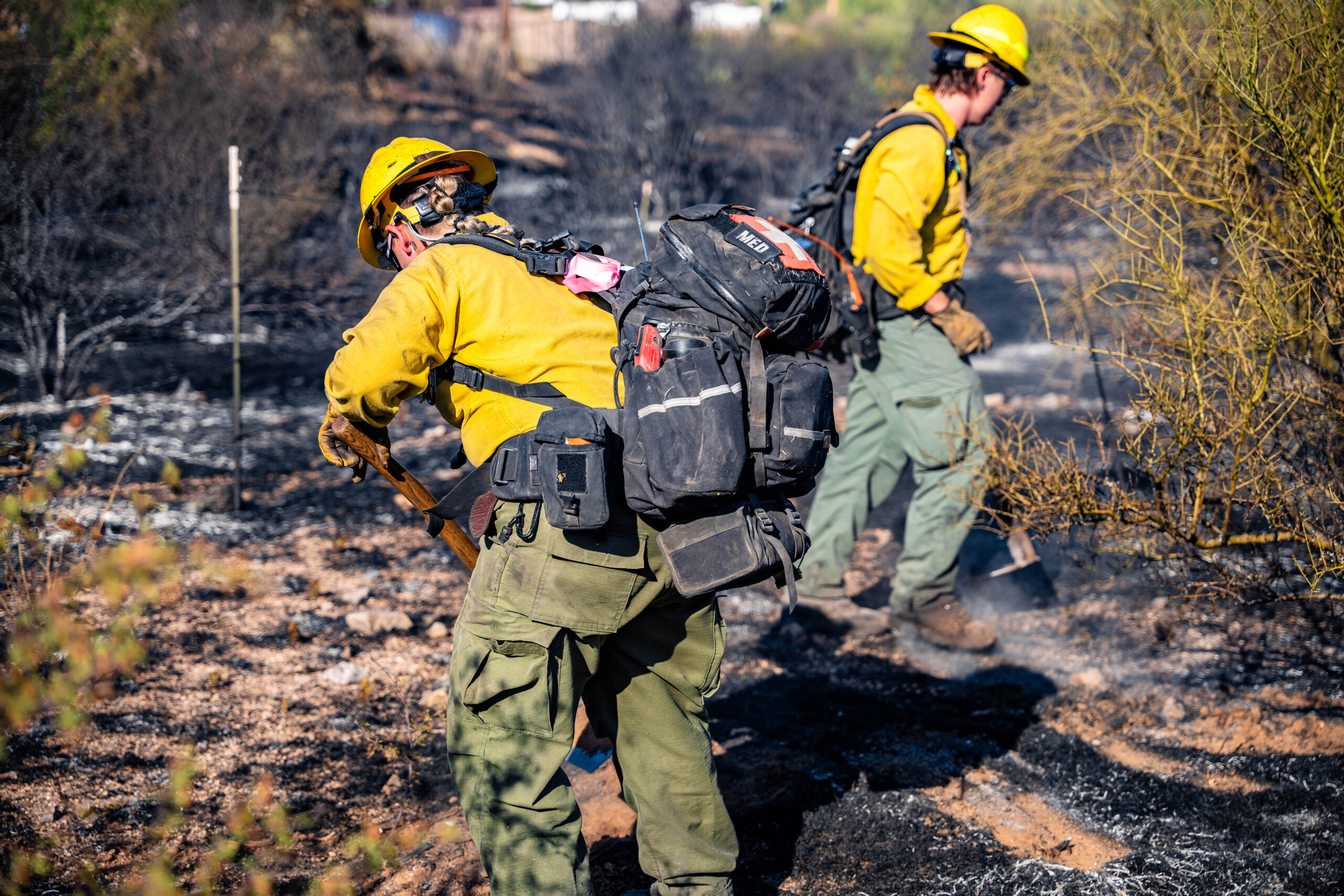Shield & Shelter

Your Comprehensive Guide to Wildfire Season Readiness
Writer Joseph J. Airdo



As Arizona’s summer approaches, so does the looming threat of wildfire season for residents in the wildland-urban interface (WUI) areas. For homeowners in Rio Verde Foothills, Desert Hills, Carefree, Cave Creek and North Scottsdale, preparation isn’t just recommended — it’s essential. The time to act is now, before the first smoke appears on the horizon.
This year’s fire season could be particularly challenging. This spring, the Arizona Department of Forestry and Fire Management warned that lingering warm and dry conditions, coupled with drought-stricken fuel, could drive widespread fire activity. More than half the state is in extreme drought status.
“This year’s season is not based on elevation or fuel type,” explains DFFM State Fire Management Officer John Truett. “A lackluster winter and spring, in terms of rain and snow, have really put us at a disadvantage statewide.”
Areas south of the Mogollon Rim, including the Sonoran Desert and southern Arizona, face potentially larger-intensity fires due to fuel types and loading. Moisture in late March and early April may have provided a brief reprieve, but officials remain concerned about the season ahead. Last year, Arizona firefighters responded to 2,162 wildfires — a 33% increase from 2023 — burning 282,507 acres across private, state and federal lands.
Recent advancements in firefighting techniques include more rapid deployment of air operations during wildfires, along with drone mapping and artificial intelligence-based prediction tools that help anticipate fire behavior. But the best defense begins with homeowners themselves.
These preparations aren’t just about protecting material investments. They’re about preserving peace of mind, family safety and community resilience during a season that grows more unpredictable each year.
This month, with Shawn Gilleland, public information officer for Rural Metro Fire and Arizona Foothills 911, as our expert guide, Images Arizona explores how to transform your property from vulnerable to vigilant.
Create Your Defensive Perimeter
“The single most important wildfire preparation is the creation of defensible space around your home,” Gilleland says. “This is particularly critical for properties located in the WUI — areas where concentrations of homes are built directly into wildland areas.”
Understanding the science behind wildfire behavior reveals why defensible space works so effectively. Fire requires three elements to thrive: fuel, heat and oxygen — often called the fire triangle.
“By removing the fuel, the fire runs out of material to consume and eventually stops or dies out,” Gilleland explains. “Clearing flammable grasses, dead brush, and ‘understory’ — all the dead material that falls from trees and bushes, such as mesquite needles and leaves — prevents fire from traveling to your home.”
The concentric ring approach to defensible space allows homeowners to prioritize their efforts, starting with the most critical areas. Gilleland recommends beginning with the first 5 feet immediately surrounding your home, creating what fire experts call the “home ignition zone.” In this area, remove all flammable materials, including mulch, dead plants, dried leaves and firewood.
“These actions improve your home’s ignition resistance, reducing the chances of windblown embers finding a place to land in flammable material, smoldering and igniting a spot fire,” Gilleland says.
From there, work outward in expanding rings — 10 feet, 20 feet, 30 feet, and ideally 100 feet if your property allows. In these zones, the goal isn’t to create a barren landscape but rather to space plants appropriately, remove ladder fuels (vegetation that allows fire to climb from the ground to treetops) and maintain trees by removing lower branches.
For luxury homeowners concerned about maintaining aesthetic appeal, defensible space doesn’t require sacrificing landscape design. Strategic placement of hardscape features like decorative stone walls, patios and water features can serve as both firebreaks and design elements. Fire-resistant plants like ice plants, aloe, lavender and many native succulents can provide color and texture while minimizing risk.
“Defensible space doesn’t mean creating a moonscape or eliminating all vegetation,” Gilleland stresses. “The idea is to space out bushes, trim up trees, remove flammable material, and increase your home’s ignition resistance.”
This preparation creates an environment in which your home has a fighting chance, even without intervention.
“The ultimate goal is to be so prepared that your home survives with little or no fire department intervention,” Gilleland says.
Plan Your Escape
While property protection is vital, personal safety remains paramount. Every family in fire-prone areas should develop a comprehensive evacuation plan before an emergency strikes.
“People living in these areas should have a comprehensive evacuation plan and a go bag ready at all times — essentially a kit containing all necessary supplies to sustain them for 72 hours away from home,” Gilleland advises.
The ideal go bag includes critical medications, personal hygiene items, copies of important documents (passports, insurance policies, birth certificates), nutritious snacks, water, clothing appropriate for the season and other essentials specific to your family’s needs. For families with pets, include food, carriers, medications and comfort items to reduce stress during evacuation.
Technology has made evacuation planning more sophisticated. Digital services allow families to store important documents securely in the cloud, accessible from any location. GPS mapping apps can help identify multiple evacuation routes from your neighborhood — an important consideration when primary routes may become congested or blocked.
Having a communication plan is equally important. Designate an out-of-area contact person who can serve as a central point of communication if family members become separated. Establish meeting locations both near your home for sudden evacuations and outside your neighborhood if immediate-area access is restricted.
Stay Informed
In wildfire situations, information becomes a critical resource. Knowing where to find reliable updates can mean the difference between a proactive response and a dangerous delay.
“Fire information can be accessed through apps like Watch Duty or by following social media accounts for the Tonto National Forest, local fire departments or county emergency management offices,” Gilleland says.
The Watch Duty app has become particularly valuable for Arizona residents, providing real-time wildfire information, evacuation updates and fire perimeter mapping. Many users appreciate the app’s straightforward interface and timely notifications.
Social media channels for the Tonto National Forest, Maricopa County Emergency Management and local fire departments provide another layer of information. These official accounts often share updates more quickly than traditional news outlets, though information should always be verified through multiple sources when possible.
“And understand that you don’t need to wait for an official evacuation order,” Gilleland emphasizes. “You always have the right to evacuate early and safely on your own terms. In fact, leaving before mandatory orders are issued often means avoiding traffic congestion and reducing stress during an already difficult situation.”
Build Community Resilience
Individual preparation is vital, but community-level initiatives can amplify effectiveness. The Firewise program, highlighted in our March issue, continues to gain traction throughout Arizona.
“At the community level, the Firewise program remains our most effective initiative,” Gilleland says. “We recently helped two local communities — Rio Verde Foothills and Granite Mountain HOA, located within Rio Verde Foothills — become recognized by the state as Firewise communities.”
These community-based approaches include neighborhood cleanup events, shared resources for vegetation management and coordinated emergency response planning. Some neighborhoods establish communication networks using platforms such as WhatsApp or Nextdoor to share real-time information during emergencies.
For those living in luxury communities and homeowners associations, advocating for fire safety assessments and communitywide preparation can improve outcomes for all residents. Consider establishing a wildfire preparedness committee within your association to coordinate efforts, share resources and develop neighborhood-specific evacuation plans.
Local fire departments often provide resources for community-level preparation. Many offer property assessments, educational workshops and guidance for establishing Firewise communities — services worth exploring before emergency situations arise.
Upgrade Your Property’s Defenses
For luxury homeowners seeking additional protection, advanced strategies exist beyond basic preparation. High-end fire protection systems, such as exterior sprinklers that activate during emergencies, can significantly increase a home’s survivability. These systems, which can cost $10,000 to $30,000, depending on property size, may create a protective moisture barrier around the structure during approaching fires.
When building or remodeling, consider fire-resistant construction materials. Cement fiber siding, metal or tile roofing, tempered dual-pane windows and enclosed eaves all improve a home’s fire resistance. For larger estates, creating strategic firebreaks using amenities such as tennis courts, swimming pools or decorative water features can serve both aesthetic and protective purposes.
Documentation is another critical aspect of advanced preparation. Create a detailed home inventory with high-resolution photos or videos of valuable items, architectural features, landscaping and art collections. Store this information securely offsite or in cloud storage along with insurance policy information.
Speaking of insurance, review your policy annually to ensure adequate coverage for rebuilding costs, which often exceed market value. Consider specialized policies for high-value homes that include features such as guaranteed replacement cost coverage and temporary housing allowances that match your lifestyle.
Prevent Fires Before They Start
While preparation is essential, prevention deserves equal attention. The vast majority of wildfires have human causes, making awareness and responsible behavior crucial.
“Perhaps most importantly, everyone should practice fire awareness,” Gilleland says. “Since the majority of wildfires are human-caused, simply preventing a fire before it starts will have the greatest impact on community safety.”
Taking responsibility for fire prevention means properly extinguishing campfires, avoiding outdoor burning during high-risk periods, maintaining vehicles to prevent sparks and reporting suspicious activity that could lead to fires, a sentiment echoed by state fire officials.
“It’s not a matter of if a fire starts, but when,” Chief Truett warns. “Be prepared and be proactive when it comes to fire. Do your due diligence when working outdoors with tools that may spark. Be a good steward of our lands and recreate responsibly.”
As wildfire season approaches, the time to prepare is now. By creating defensible space, developing evacuation plans, staying informed, engaging with community initiatives and exploring advanced protection strategies, Arizona homeowners can significantly improve their odds of weathering wildfire season safely.
The peace of mind that comes from proper preparation is invaluable — knowing you’ve done everything possible to protect your family and property allows you to enjoy Arizona’s beautiful landscape, even during challenging seasons. With thoughtful preparation and community cooperation, we can all face wildfire season with confidence rather than fear.

